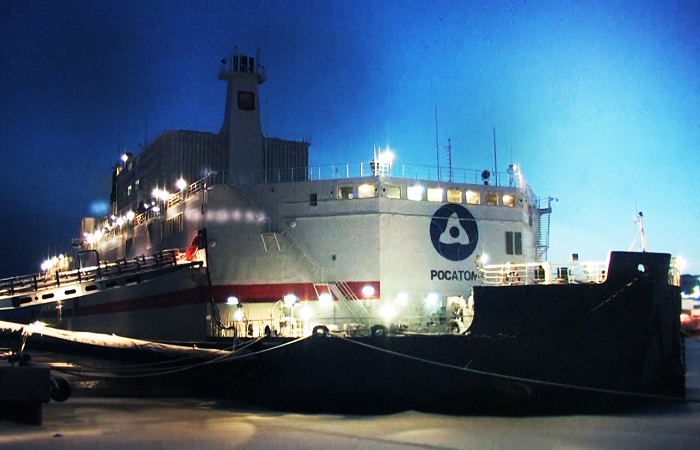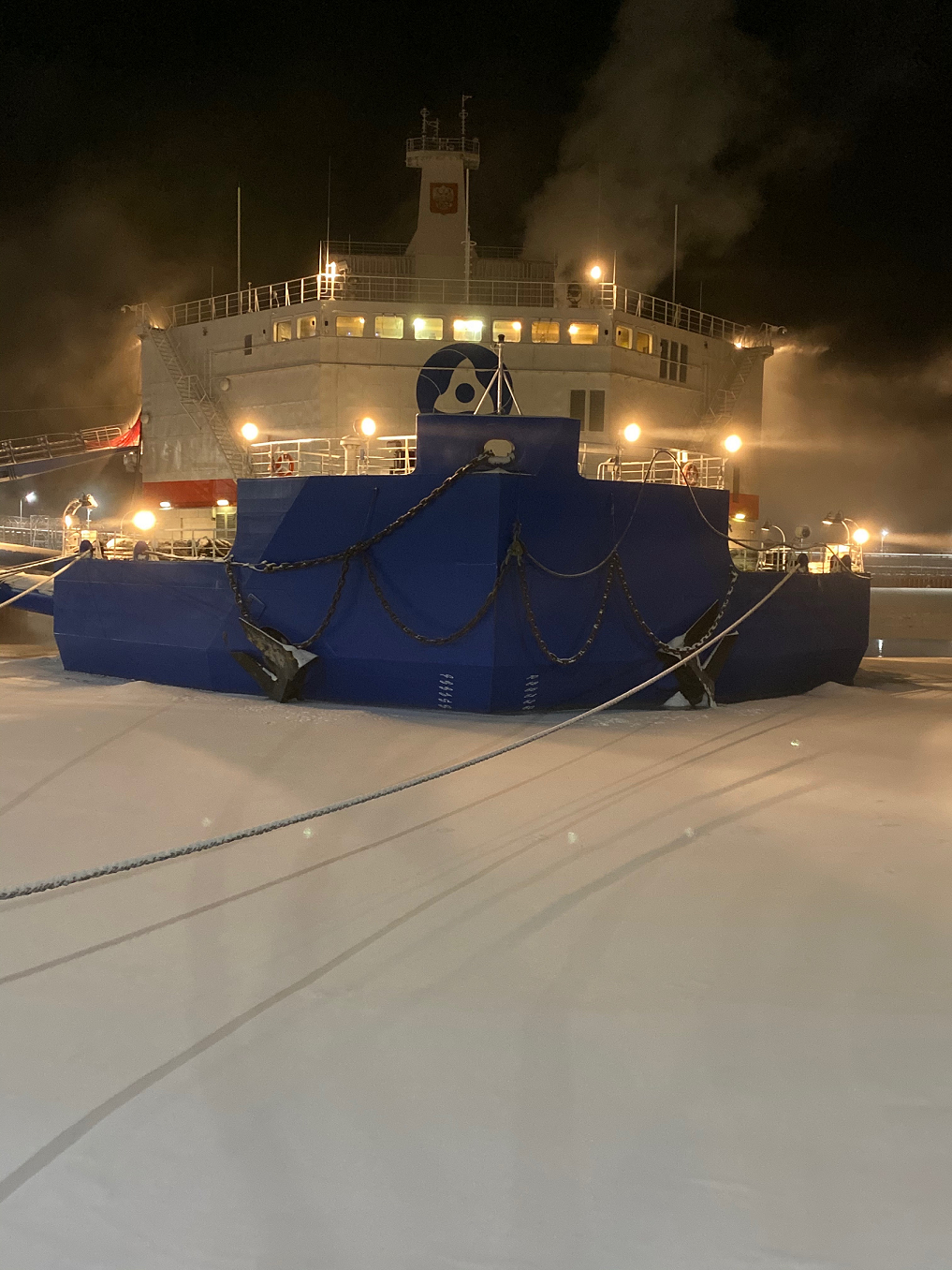On December 19th, the world’s first floating nuclear power plant (FNPP) the Akademik Lomonosov produced its first electric energy to begin and power the city of Pevek, in the Chukotka Autonomous District, Russia.
The Akademik Lomonosov began work at 11:00 AM Moscow time, Rosenergoatom Concern JSC announced, which is a subsidiary of Rosatom.
As a symbol to welcome New Year’s Eve, a New Year decorated tree was lit with the power from the FNPP.
The FNPP consists of the Akademik Lomonosov floating power unit (FPU) and its coastal infrastructure.
The generated electricity goes to the Chaun-Bilibino junction of the Chukotka Autonomous District. Earlier, the commission of the Far Eastern Department of the Federal Service for Ecological, Technological and Nuclear Supervision (Rostekhnadzor) issued a permit for the operation of the electrical installation, and permission was also obtained for its connection to the northern electric networks of Chukotenergo JSC.
“Today, a historic event took place – the first connection of the Akademik Lomonosov FPU generators to the network was carried out. Thus, a major step was taken towards the development of Pevek as the new energy capital of the region, a stronghold for the development of western Chukotka and a key link in the Northern Sea Route. The main task of the current year was successfully completed, and the task for the next 2020 is to complete the commissioning of the FNPP for commercial operation,” the Director General of Rosenergoatom Concern JSC Andrei Petrov commented.
The connection of the FPU generators to the network was carried out after synchronization with the parameters of the coastal network.
This was preceded by the completion of the construction of the coastal facilities that ensure the transfer of electric energy from the FPU to the high-voltage networks of the Chukotka Autonomous Region. A large amount of work was also carried out on the construction of engineering heat supply networks. Connection to Pevek’s heating networks will be made in 2020.
“The specialists conducted a large set of tests and inspections at various stages of capacity development. All measures necessary to confirm the reliability and safety of the FNPP operation were carried out in accordance with the schedule,” the director of the Rosenergoatom Concern JSC branch of the Directorate for the Construction and Operation of Floating Nuclear Thermal Power Plants Vitaly Trutnev said.
He also emphasized that safety issues have always remained the main priority in the construction of the FNPP, therefore, the power plant was set up in stages, with the necessary tests of the FNPP equipment in order to guarantee its safe operation.
After the commissioning of the FNPP, the number of operating nuclear power plants in Russia will increase from 10 to 11. In addition, for the first time in the history of the Russian nuclear energy industry, two operating nuclear power plants, the FNPP and the Bilibino Nuclear Power Plant (NPP) will be located on the territory of the same district.
The floating nuclear power plant (FNPP) the Akademik Lomonosov floating power unit and coastal hydraulic structures is designed to power the Chukotka Autonomous District and supply heat to the city of Pevek.
In the future, the FNPP will replace the capacities of the technologically obsolete Bilibino NPP and the coal Chaun Thermal Power Plant.
After commissioning, the FNPP will become the northernmost nuclear power plant in the world, taking this title from the Bilibino NPP. Placing the station in Pevek will create conditions for the accelerated socio-economic development of the Chaunsky municipal region and Chukotka as a whole. In addition, it will become one of the key infrastructure elements in the framework of the Northern Sea Route development program.
The station is equipped with two KLT-40S icebreaker-type reactors that are capable of generating up to 70 MW of electricity and 50 Gcal/h of thermal energy, which is enough to ensure energy consumption in a city with a population of about 100,000 people.
Currently, Russia’s Atomic Energy Corporation Rosatom is already working on the second generation of the FNPP – the Optimized Floating Power Unit (OFPU), which will be smaller and more powerful than its predecessor. It is supposed to be equipped with two RITM-200M reactors with a total capacity of 100 MW.
The chief designer, manufacturer and supplier of reactor facilities is JSC Afrikantov OKBM (Nizhny Novgorod).
The Project 20870 FPU is a smooth-deck non-self-propelled vessel with a length of 144.2 meters, a width of 30 meters, a draft of 5.6 meters, and a displacement of 21,560 tons. It has a crew of 69 people.
The floating nuclear power plant (FNPP) consists of a floating power unit (FPU), a coastal site with facilities that provide electricity and heat to consumers, as well as hydraulic structures that ensure safe harbor of the FPU in the water area.
The assigned service life of the FPU is 40 years. The designated service life before the necessity for inspections and factory repairs is 12 years. The operating time of reactor installations between overloads of the core is 3 years.
All nuclear fuel and radioactive material handling systems are located inside the FPU. The core reloading and storage of spent fuel is carried out on board the FPU.
On June 30th, 2010 the Akademik Lomonosov FPU was launched in St. Petersburg at the Baltic Shipyard. However, steam generating units were loaded onto the FPU on September 27th and October 1st, 2013. Under the terms of the new contract, the Baltic Shipyard pledged to hand over the PSA, ready for towing to the place of operation, on September 9th, 2016.
On October 4th, 2016, the construction of the coastal infrastructure of the FNPP in Pevek (Chukotka Autonomous Region) began.
The towing of the completed Akademik Lomonosov FPU from the Baltic plant to Murmansk was started on April 28th, 2018, the power unit arrived in Murmansk on May 19th, 2018.
The loading of nuclear fuel into the first reactor of the power unit was started there on July 25th, 2018, and into the second reactor on September 28th.
On August 23th, 2019, the Akademik Lomonosov SEB was sent by tow from Murmansk to Pevek, where it arrived on September 14th, 2019.
MORE ON THE TOPIC:







